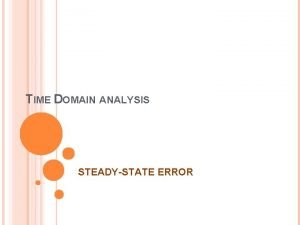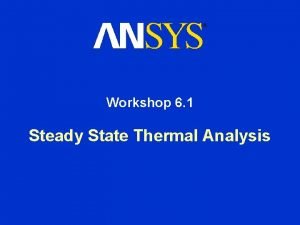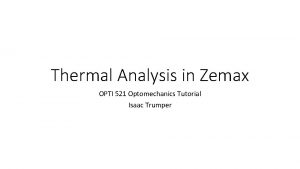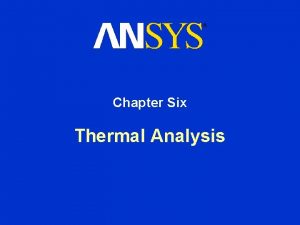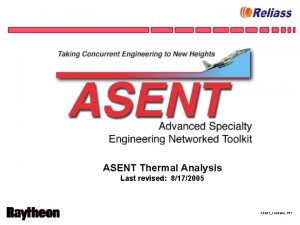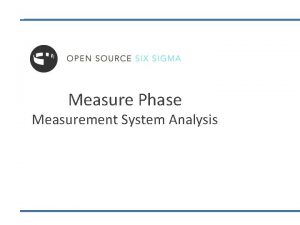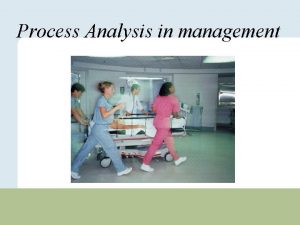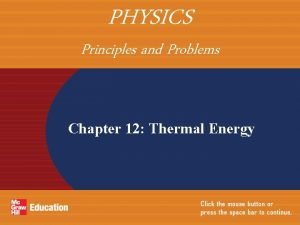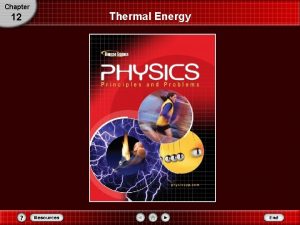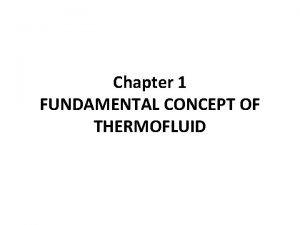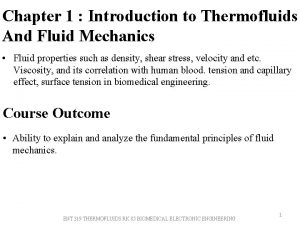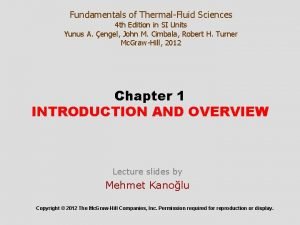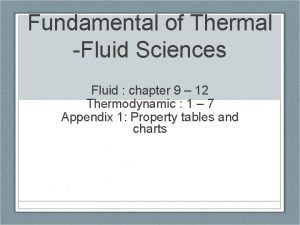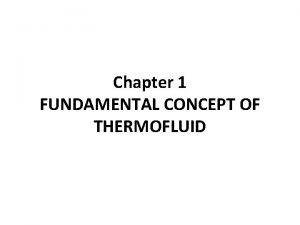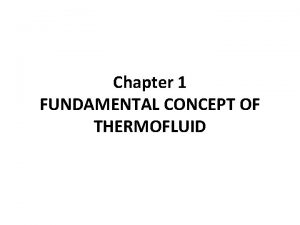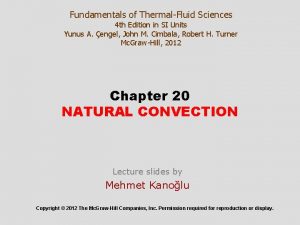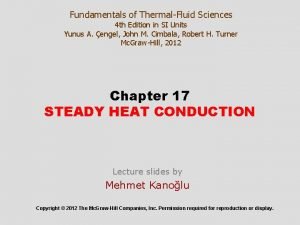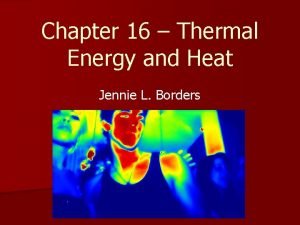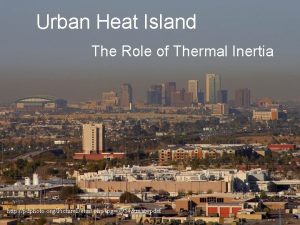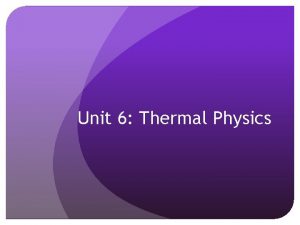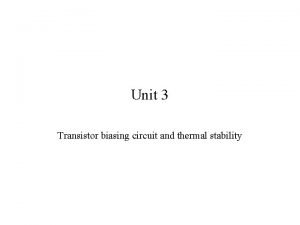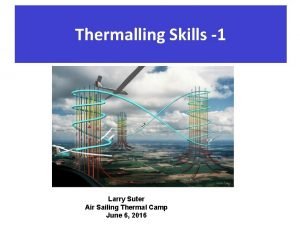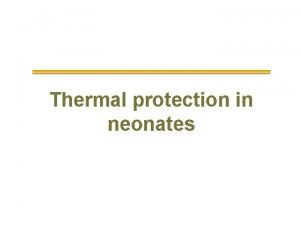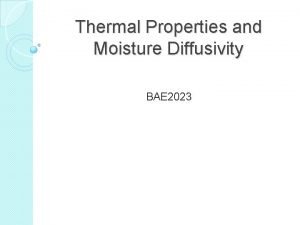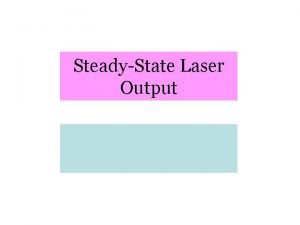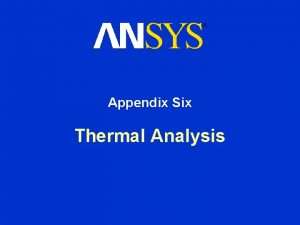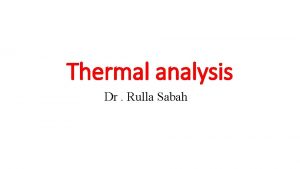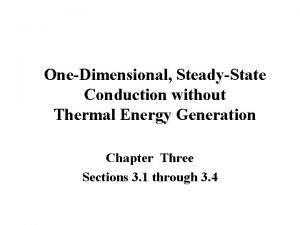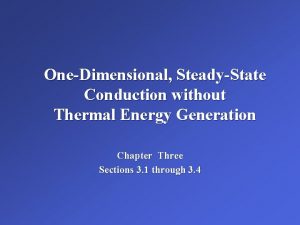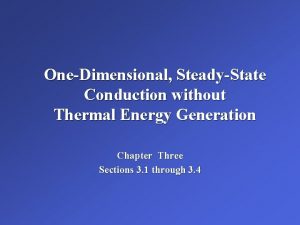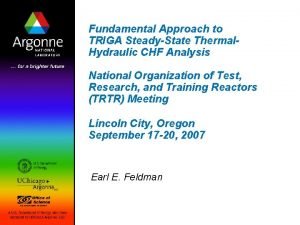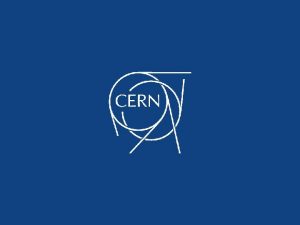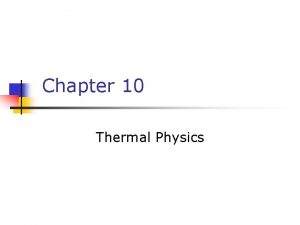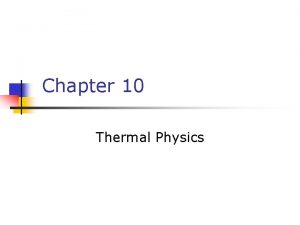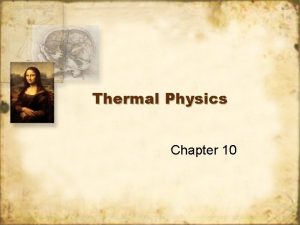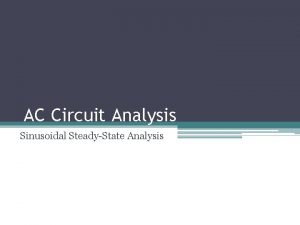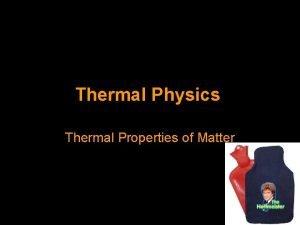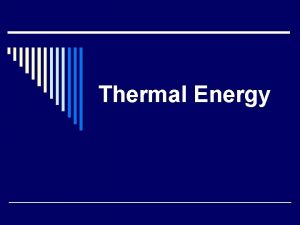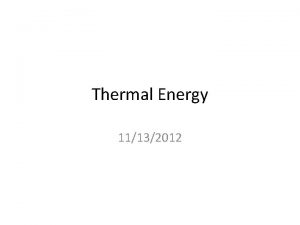Chapter Six Thermal Analysis SteadyState Thermal Analysis Chapter








































- Slides: 40

Chapter Six Thermal Analysis

Steady-State Thermal Analysis Chapter Overview Training Manual – Geometry and Elements – Contact and Types of Supported Assemblies – Environment, including Loads and Supports – Solving Models – Results and Postprocessing • The capabilities described in this section are generally applicable to ANSYS Design. Space Entra licenses and above, except for an ANSYS Structural license. – Some options discussed in this chapter may require more advanced licenses, but these are noted accordingly. ANSYS Workbench – Simulation • In this chapter, performing steady-state thermal analyses in Simulation will be covered: – It is assumed that the user has reviewed Chapters 1 -3 prior to this chapter. (Chapters 4 -5 are optional) March 29, 2005 Inventory #002215 6 -2

Steady-State Thermal Analysis Basics of Steady-State Heat Transfer Training Manual This results in the following assumptions: – No transient effects are considered in a steady-state analysis – [K] can be constant or a function of temperature • Temperature-dependent thermal conductivity can be input for each material property – {Q} can be constant or a function of temperature • Temperature-dependent film coefficients can be input for convective boundary conditions ANSYS Workbench – Simulation • For a steady-state (static) thermal analysis in Simulation, the temperatures {T} are solved for in the matrix below: March 29, 2005 Inventory #002215 6 -3

Steady-State Thermal Analysis Basics of Steady-State Heat Transfer Training Manual – This means that thermal analysis Simulation solves for is a conduction-based equation. • Heat flow within a solid (Fourier’s Law) is the basis of [K] • Heat flux, heat flow rate, and convection are treated as boundary conditions on the system {Q} • No radiation is currently considered • No time-dependent effects are currently considered – Heat transfer analysis is different from CFD (Computational Fluid Dynamics) • Convection is treated as a simple boundary condition, although temperature-dependent film coefficients are possible. • If a conjugate heat transfer/fluid problem needs to be analyzed, one must use ANSYS CFD tools instead. • It is important to remember these assumptions related to performing thermal analyses in Simulation. ANSYS Workbench – Simulation • Fourier’s Law provides the basis of the previous equation: March 29, 2005 Inventory #002215 6 -4

Steady-State Thermal Analysis Physics Filters Training Manual – Under “View menu > Physics Filter, ” unselect the “Structural” option. Now, the available options in the Simulation GUI will only reflect thermal analyses. – This applies to options in the “Environment” and “Solution” levels only. – If a thermal-stress simulation is to be performed, do not turn off any physics filters since both structural and thermal options may be required. ANSYS Workbench – Simulation • Before proceeding to a detailed discussion on performing thermal analyses in Simulation, it is useful to point out that if a thermal-only solution is to be performed, the Physics Filter can be useful to filter the GUI. March 29, 2005 Inventory #002215 6 -5

Steady-State Thermal Analysis A. Geometry Training Manual – Solid, surface, and line bodies are supported by all products which support thermal analyses. • For surface bodies, thickness must be input in the Details view of the Geometry branch • The cross-section and orientation of line bodies is defined within Design. Modeler and is imported into Simulation automatically. Although the cross-section and orientation is defined, this information is meant for structural analyses, and the actual thermal link element will have an ‘effective’ cross-section based on the input properties. • No heat flux or vector heat flux output is available with line bodies. Only temperature results are available for line bodies. – The “Point Mass” feature is not applicable in thermal analyses ANSYS Workbench – Simulation • In thermal analyses, all types of bodies supported by Simulation may be used. • Point Mass is described in Chapter 4, Linear Structural Analysis. March 29, 2005 Inventory #002215 6 -6

Steady-State Thermal Analysis … Geometry Training Manual – For shell bodies, through-thickness temperature gradients are not considered. A shell body should be used for thin structures when it can be safe to assume temperatures on top and bottom of surface are the same. • Temperature variation will still be considered across the surface, just not through the thickness, which is not explicitly modeled. – For line bodies, thickness variation in the cross-section is not considered. A line body should be used for beam- or truss-like structures, where the temperature can be assumed to be constant across the cross-section. • Temperature variation will still be considered along the line body, just not through the cross-section, which is not explicitly modeled. ANSYS Workbench – Simulation • It is important to understand assumptions related to using shell and line bodies: March 29, 2005 Inventory #002215 6 -7

Steady-State Thermal Analysis … Material Properties Training Manual – Material input is under the “Engineering Data” tab, and material assignment is per part under the “Geometry” branch – Thermal Conductivity is input under the Engineering Data tab. Temperature-dependent thermal conductivity can be input as a table. – Other material input is not used in thermal. ANSYS Workbench – Simulation • The only required material property is thermal conductivity. If any temperature-dependent material properties exist, this will result in a nonlinear solution. This is because the temperatures are solved for, but the materials are dependent on the temperatures, so it is not linear. March 29, 2005 Inventory #002215 6 -8

Steady-State Thermal Analysis B. Assemblies – Solid Body Contact Training Manual – Surface-to-surface contact allows non-matching meshes at boundaries between solid parts – Contact enables heat transfer between parts in an assembly Model shown is from a sample Inventor assembly. ANSYS Workbench – Simulation • When importing assemblies of solid parts, contact regions are automatically created between the solid bodies. March 29, 2005 Inventory #002215 6 -9

Steady-State Thermal Analysis … Assemblies – Contact Region Training Manual – One side of the contact region is comprised of “contact” face(s), the other side of the region is made of “target” face(s). – Heat flow is allowed between contact and target faces (based on the contact normal direction) • When one side is the contact and the other side is the target, this is called asymmetric contact. On the other hand, if both sides are made to be contact & target, this is called symmetric contact. However, the designation of which side is contact or target is unimportant in thermal analysis. • By default, Simulation uses symmetric contact for solid assemblies. • For ANSYS Professional licenses and above, the user may change to asymmetric contact, as desired. ANSYS Workbench – Simulation • In Simulation, the concept of contact and target surfaces are used for each contact region. March 29, 2005 Inventory #002215 6 -10

Steady-State Thermal Analysis … Assemblies – Contact Region Training Manual – No heat spreading is considered in the contact/target interface • Heat spreading is considered within shell or solid elements at the contact or target surfaces because of Fourier’s Law • Heat flow within the contact region is in the contact normal direction only • This means that, regardless of the definition of the contact region, heat flows only if a target element is present in the normal direction In the figure on the left, the solid green double-arrows indicate heat flow within the contact region. Heat flow only occurs if a target surface is normal to a contact surface. ANSYS Workbench – Simulation • As noted in the previous slide, heat flows within a contact region in the contact normal direction The light, dotted green arrows indicate that no heat transfer will occur between parts. March 29, 2005 Inventory #002215 6 -11

Steady-State Thermal Analysis … Assemblies – Contact Region Training Manual – The contact “Type” is meant for structural applications – If the parts are initially in contact, heat transfer will occur between the parts. If the parts are initially out of contact, the parts will not transfer heat between each other. – Based on the contact type, whether heat will be transferred between contact and target surfaces is outlined below: – The pinball region is automatically defined and set to a relatively small value to accommodate small gaps which may present in the model. The pinball region will be discussed next. ANSYS Workbench – Simulation • In Simulation, various contact behaviors exist March 29, 2005 Inventory #002215 6 -12

Steady-State Thermal Analysis … Assemblies – Contact Region – If the target nodes lie within the pinball region and the contact is bonded or no separation, then heat transfer will occur (solid green lines) – Otherwise, no heat transfer will occur between nodes (dotted green lines) Pinball Radius In this figure on the right, the gap between the two parts is bigger than the pinball region, so no heat transfer will occur between the parts ANSYS Workbench – Simulation • The pinball region may be input and visualized in ANSYS Professional licenses and above. Training Manual March 29, 2005 Inventory #002215 6 -13

Steady-State Thermal Analysis … Assemblies – Thermal Conductance Training Manual – The amount of heat flow between two parts is defined by the contact heat flux q: where Tcontact is the temperature of a contact “node” and Ttarget is the temperature of the corresponding target “node” located in the contact normal direction. – By default, TCC is set to a relatively ‘high’ value, based on the largest material conductivity defined in the model KXX and the diagonal of the overall geometry bounding box ASMDIAG. ANSYS Workbench – Simulation • By default, a high thermal contact conductance (TCC) is defined between parts of an assembly This essentially provides ‘perfect’ conductance between parts. March 29, 2005 Inventory #002215 6 -14

Steady-State Thermal Analysis … Assemblies – Thermal Conductance Training Manual • One may want to include finite thermal conductance instead – Two surfaces (at different temperatures) in contact experience a temperature drop across the interface. The drop is due to imperfect contact between the two surfaces. The imperfect contact, and hence the finite contact conductance, can be influenced by many factors such as: • surface flatness • surface finish • oxides DT • entrapped fluids • contact pressure • surface temperature • use of conductive grease ANSYS Workbench – Simulation • Perfect thermal contact conductance between parts means that no temperature drop is assumed at the interface. T x March 29, 2005 Inventory #002215 6 -15

Steady-State Thermal Analysis … Assemblies – Thermal Conductance Training Manual – The thermal contact conductance per unit area is input for each contact region in the Details view, as shown below. – If thermal contact resistance is known, invert this value and divide by the contacting area to obtain TCC value. – When this is done, there will now be a temperature drop between the contact and target surfaces for a contact region. If “Thermal Conductance” is left at “Program Chosen, ” nearperfect thermal contact conductance will be defined. The user can change this to “Manual” to input finite thermal contact conductance instead, which is the same as including thermal contact resistance at a contact interface. ANSYS Workbench – Simulation • In ANSYS Professional licenses and above, the user may define a finite thermal contact conductance (TCC) if the Pure Penalty or Augmented Lagrange Formulation is used. March 29, 2005 Inventory #002215 6 -16

Steady-State Thermal Analysis … Assemblies – Thermal Conductance – Input values as normal • MPC bonded contact allows for perfect thermal contact conductance. – In this case, no thermal contact conductance is used nor defined because ‘contact’ is related via constraint equations. – The contact “node” and corresponding target “node” will have the same temperature because of perfect contact conductance. Do not use “Normal Lagrange” formulation for thermal analyses. If selected, the ANSYS solver will actually use “Augmented Lagrange” with a ‘perfect’ thermal contact conductance. ANSYS Workbench – Simulation • If using symmetric contact, the user does not need to account for a ‘double’ thermal contact resistance. Training Manual March 29, 2005 Inventory #002215 6 -17

Steady-State Thermal Analysis … Assemblies – Surface Body Contact – Allows for more complex modeling of assemblies, taking advantage of the benefits of shells, when applicable ANSYS Workbench – Simulation • For ANSYS Professional licenses and above, mixed assemblies of shells and solids are supported Training Manual March 29, 2005 Inventory #002215 6 -18

Steady-State Thermal Analysis … Assemblies – Surface Body Contact – For contact including shell faces or solid edges, only bonded or no separation behavior is allowed. – For contact involving shell edges, only bonded behavior using MPC formulation is allowed. • For MPC-based bonded contact, user can set the search direction (the way in which the multi-point constraints are written) as either the target normal or pinball region. • If a gap exists (as is often the case with shell assemblies), the pinball region can be used for the search direction to detect contact beyond a gap. ANSYS Workbench – Simulation • Edge contact is a subset of general contact Training Manual • MPC results in perfect contact conductance March 29, 2005 Inventory #002215 6 -19

Steady-State Thermal Analysis … Assemblies – Spot Weld Training Manual – Spotweld definition is done in the CAD software. Currently, only Design. Modeler and Unigraphics define spotwelds in a manner that Simulation supports. – Spotwelds can also be created in Simulation manually, but only at discrete vertices. ANSYS Workbench – Simulation • Spot welds provide a means of connecting shell assemblies at discrete points for heat transfer March 29, 2005 Inventory #002215 6 -20

Steady-State Thermal Analysis C. Loads Training Manual – Heat Loads: • These loads pump heat into the system. • Heat loads can be input as a known heat flow rate or heat flow rate per unit area or unit volume. – Adiabatic Condition: • This is the naturally-occurring boundary condition, where there is not heat flow through the surface. – Thermal Boundary Conditions: • These boundary conditions act as heat sources or heat sinks with a known temperature condition. • These can be either a prescribed temperature or a convection boundary condition with a known bulk temperature. ANSYS Workbench – Simulation • There are three types of loads in thermal analyses: March 29, 2005 Inventory #002215 6 -21

Steady-State Thermal Analysis … Heat Loads Training Manual – A heat flow rate can be applied to a vertex, edge, or surface. The load gets distributed for multiple selections. – Heat flow has units of energy/time (i. e. , power). • Heat Flux: – A heat flux can be applied to surfaces only. – Heat flux has units of energy/time/area (i. e. , power/area) • Internal Heat Generation: – An internal heat generation rate can be applied to bodies only. – Heat generation has units of energy/time/volume A positive value for heat load will add energy to the system. Also, if multiple loads are present, the effect is cumulative. ANSYS Workbench – Simulation • Heat Flow: March 29, 2005 Inventory #002215 6 -22

Steady-State Thermal Analysis … Adiabatic Conditions Training Manual – Perfectly insulated condition is applied to surfaces – Can be thought of as a zero heat flow rate loading – This is actually the naturally-occurring condition in thermal analyses, when no load is applied. • Usually, one does not need to apply a perfectly insulated condition on surfaces since that is the natural behavior for a regular surface. • Hence, this loading is meant to be used as a way to remove loading on specified surfaces. For example, it may be easier for a user to apply heat flux or convection on all surfaces, then use the perfectly insulated condition to selectively ‘remove’ the loading on some surfaces (such as those in contact with other parts). ANSYS Workbench – Simulation • Perfectly Insulated: March 29, 2005 Inventory #002215 6 -23

Steady-State Thermal Analysis … Thermal Boundary Conditions Training Manual • At least one type of thermal boundary condition must be present. Otherwise, the steady-state temperature will be infinite if only heat is pumped into a system! • Also, Given Temperature or Convection load should not be applied on surfaces that already have another heat load or thermal boundary condition applied to it. – If applied on an entity which also has a heat load, the temperature boundary condition will override. – Perfect insulation will override thermal boundary conditions. • Given Temperature: – This imposes a temperature on vertices, edges, or surfaces. ANSYS Workbench – Simulation Thermal boundary conditions present a known local or ‘remote’ temperature condition. – Temperature is the degree of freedom solved for, but this fixes the temperature on selected entities to a given value. March 29, 2005 Inventory #002215 6 -24

Steady-State Thermal Analysis … Thermal Boundary Conditions Training Manual – Applied to surfaces only. – Convection relates a ‘ambient temperature’ with the surface temperature: where the convective heat flux q is related to a film coefficient h, the surface area A, and the difference in the surface temperature Tsurface & ambient temperature Tbulk. – Meant to provide a simplified way of accounting for heat transport from a fluid. “h” and “Tbulk” are user-input values. – The film coefficient h can be constant or input from a file (next) ANSYS Workbench – Simulation • Convection: March 29, 2005 Inventory #002215 6 -25

Steady-State Thermal Analysis … Thermal Boundary Conditions Training Manual – If film coefficient h is input from a file, this can be a constant or temperature-dependent value h(T). • Define a convection boundary condition under the Environment branch and define the Type to be “Temperature-Dependent”. Next, select “New Convection…” for the Correlation. The “Engineering Data” tab will open and the Coefficient Type can then be defined for the new convection load. • Determine what temperature is used for h(T) first, for temperaturedependent film coefficients. Temperature can be: – Average film temperature T=(Tsurface+Tbulk)/2 – Surface temperature T= Tsurface – Bulk temperature T= Tbulk – Difference of surface and bulk temperatures T=(Tsurface-Tbulk) Select the temperaturedependency from the pull-down menu ANSYS Workbench – Simulation • Temperature-Dependent Convection (continued): March 29, 2005 Inventory #002215 6 -26

Steady-State Thermal Analysis … Thermal Boundary Conditions Training Manual • After the type of temperature-dependency is selected, the user may input the film coefficients and temperatures in a table. The values are plotted on a graph, as shown below. ANSYS Workbench – Simulation • Temperature-Dependent Convection (continued): If any temperature-dependent convection load is applied, this will result in a nonlinear solution since the surface temperature is solved for, but the film coefficient h is based on a function of the surface temperature. Right mouse click on the table to add or delete values. The only exception is if the film coefficient h is based on a function of the bulk temperature only. In Simulation, the bulk temperature is constant and input by the user, so this load will not be nonlinear. March 29, 2005 Inventory #002215 6 -27

Steady-State Thermal Analysis … Thermal Boundary Conditions • The convection data can also be imported from a file. ANSYS Workbench – Simulation • Temperature-Dependent Convection (continued): Training Manual March 29, 2005 Inventory #002215 6 -28

Steady-State Thermal Analysis … Thermal Loads Summary Training Manual – There are some types of loads that do not have any analogy • There is no thermal equivalent for inertial loads such as rotational velocity or acceleration • The analogy of convective boundary condition is a ‘foundation stiffness’ support in structural terms, similar to a grounded spring ANSYS Workbench – Simulation • For some structural users, it may be useful to provide an analogy of structural and thermal analyses: March 29, 2005 Inventory #002215 6 -29

Steady-State Thermal Analysis D. Solution Options Training Manual – The ANSYS database can be saved if “Save ANSYS db” is set • Useful if you want to open a database in ANSYS – Two solvers are available in Simulation • The default solver is automatically chosen and does not usually need to be changed. • The “Iterative” solver can be efficient for solving large models whereas the “Direct” solver is a robust solver and handles any situation. • The ability to change the default solver is under “Tools > Options… > Simulation: Solution > Solver Type” – The “Weak Springs” and “Large Deflection” options are meant for structural analyses only, so they can be ignored for a thermal analysis. ANSYS Workbench – Simulation • Solution options can be set under the “Solutions” branch: March 29, 2005 Inventory #002215 6 -30

Steady-State Thermal Analysis … Solution Options Training Manual • For a regular thermal analysis, the “Analysis Type” will be set to “Static Thermal. ” If structural supports and results are present, then the analysis type will be “Thermal Stress. ” • A nonlinear solution will be required if temperature-dependent (a) material properties or (b) convection film coefficients are present. This means that several internal iterations will be run to achieve heat equilibrium. • The solver working directory is where scratch files are saved during the solution of the equations. By default, the TEMP directory of your Windows system environment variable is used, although this can be changed in “Tools > Options… > Simulation: Solution > Solver Working Directory”. – Any solver messages which appear after solution can be checked afterwards under “Solver Messages” ANSYS Workbench – Simulation – Informative settings show the user the status of the analysis: March 29, 2005 Inventory #002215 6 -31

Steady-State Thermal Analysis … Solving the Model Training Manual – By default, two processors (if present) will be used for parallel processing. To change this, use “Tools > Options… > Simulation: Solution > Number of Processors to Use” – Recall that if a “Solution Information” branch is requested, the details of the solution output can be examined. ANSYS Workbench – Simulation • To solve the model, request results first (covered next) and click on the “Solve” button on the Standard Toolbar March 29, 2005 Inventory #002215 6 -32

Steady-State Thermal Analysis … Solving the Model Training Manual – Structural loads are optional but can also be added. – Simulation will know that a thermal-stress analysis is to be performed (under Details view of the Solution branch). The following will be performed automatically: • A steady-state thermal analysis will be performed • The temperature field will be mapped back onto the structural model • A structural analysis will be performed – See Chapter 4 for details on Structural Analyses – Simulation automates this type of coupled-field solution, so the user does not have to worry about the above details. ANSYS Workbench – Simulation • To perform a thermal-stress solution, simply add structural support(s) and request structural results, then solve the model. March 29, 2005 Inventory #002215 6 -33

Steady-State Thermal Analysis E. Results and Postprocessing Training Manual – Temperature – Heat Flux – “Reaction” Heat Flow Rate • In Simulation, results are usually requested before solving, but they can be requested afterwards, too. – If you solve a model then request results afterwards, click on the “Solve” button , and the results will be retrieved. A new solution is not required for retrieving output of a solved model. ANSYS Workbench – Simulation • Various results are available for postprocessing: March 29, 2005 Inventory #002215 6 -34

Steady-State Thermal Analysis … Temperature – Temperature is the degree of freedom solved for, and it is the most basic output request. – Temperature is a scalar quantity and, therefore, has no direction associated with it. ANSYS Workbench – Simulation • Temperature contour plots can be requested: Training Manual March 29, 2005 Inventory #002215 6 -35

Steady-State Thermal Analysis … Heat Flux Training Manual – Heat flux q is defined as and is related to thermal gradient T. The heat flux output has three components and can aid the user in seeing how the heat is flowing. – The magnitude plotted as contours: “Total Heat Flux” – The magnitude & direction as vectors: “Vector Heat Flux” • Recall that wireframe is best for viewing vectors – Components of heat flux can be requested with “Directional Heat Flux” and can be mapped on any coordinate system. ANSYS Workbench – Simulation • Heat flux contour or vector plots are available: March 29, 2005 Inventory #002215 6 -36

Steady-State Thermal Analysis … Reaction Heat Flow Rate Training Manual – Recall that both given temperature and convection supply a known temperature, either directly or indirectly. Hence, this acts as a heat source/sink, and the amount of heat flowing in (positive) or out (negative) of the support can be output. – For each individual Given Temperature or Convection load, the Reaction heat flow rate is printed in the Details view after a solution. ANSYS Workbench – Simulation • Reaction heat flow rates is available for any Given Temperature or Convection boundary condition March 29, 2005 Inventory #002215 6 -37

Steady-State Thermal Analysis … Reaction Heat Flow Rate Training Manual – If a thermal support shares a vertex, edge, or surface with anothermal support or load, the reported reaction heat flow rate may be incorrect. This is due to the fact that the underlying mesh will have multiple supports applied to the same nodes. The solution will still be valid, but the reported values may not be accurate because of this. ANSYS Workbench – Simulation • The “Worksheet” tab for “Environment” branch has a tabular summary of reaction heat flow rates. March 29, 2005 Inventory #002215 6 -38

Steady-State Thermal Analysis F. Workshop 6 Training Manual • Goal: – Analyze the pump housing shown below for its heat transfer characteristics. ANSYS Workbench – Simulation • Workshop 6 – Thermal Analysis March 29, 2005 Inventory #002215 6 -39

March 29, 2005 Inventory #002215 6 -40
 Steadystate error
Steadystate error System type 0 1 2
System type 0 1 2 Section 3 using thermal energy
Section 3 using thermal energy Thermal transfer vs direct thermal printing
Thermal transfer vs direct thermal printing A polygon with six congruent sides and six congruent angles
A polygon with six congruent sides and six congruent angles Steady state thermal analysis
Steady state thermal analysis Differential thermal analysis graph
Differential thermal analysis graph Zemax tutorials
Zemax tutorials Differential thermal analysis
Differential thermal analysis What is steady-state thermal analysis?
What is steady-state thermal analysis? Thermal analysis ppt
Thermal analysis ppt Dsc
Dsc Msa attribute study kappa xls
Msa attribute study kappa xls List the six steps of business transaction analysis.
List the six steps of business transaction analysis. The six step blueprint for process analysis begins with:
The six step blueprint for process analysis begins with: Six sigma at academic medical hospital case analysis
Six sigma at academic medical hospital case analysis Chapter 12 thermal energy
Chapter 12 thermal energy Chapter 17 thermal and sound insulation
Chapter 17 thermal and sound insulation Chapter 12 thermal energy answers
Chapter 12 thermal energy answers Fundamentals of thermal-fluidsciences chapter 1 problem 11p
Fundamentals of thermal-fluidsciences chapter 1 problem 11p Examples of the respiratory system
Examples of the respiratory system Fundamentals of thermal-fluidsciences chapter 2 problem 13p
Fundamentals of thermal-fluidsciences chapter 2 problem 13p Fundamentals of thermal-fluidsciences chapter 2 problem 47p
Fundamentals of thermal-fluidsciences chapter 2 problem 47p Fundamentals of thermal-fluidsciences chapter 1 problem 19p
Fundamentals of thermal-fluidsciences chapter 1 problem 19p Fundamentals of thermal-fluidsciences chapter 1 problem 13p
Fundamentals of thermal-fluidsciences chapter 1 problem 13p Fundamentals of thermal-fluidsciences chapter 1 problem 24p
Fundamentals of thermal-fluidsciences chapter 1 problem 24p Fundamentals of thermal-fluidsciences chapter 2 problem 30p
Fundamentals of thermal-fluidsciences chapter 2 problem 30p Fundamentals of thermal-fluidsciences chapter 2 problem 28p
Fundamentals of thermal-fluidsciences chapter 2 problem 28p Chapter 16 thermal energy and heat
Chapter 16 thermal energy and heat Thermal energy and mass
Thermal energy and mass Chapter 6 review
Chapter 6 review Thermal inertia
Thermal inertia Thermal expansion examples
Thermal expansion examples What is thermal stability in transistor
What is thermal stability in transistor What is the difference between thermal energy and heat?
What is the difference between thermal energy and heat? How does conduction transfer heat
How does conduction transfer heat Thermalling techniques
Thermalling techniques Thermoneutral environment for neonates
Thermoneutral environment for neonates How to calculate heat capacity
How to calculate heat capacity Spcific heat of water
Spcific heat of water Conductivity k
Conductivity k
